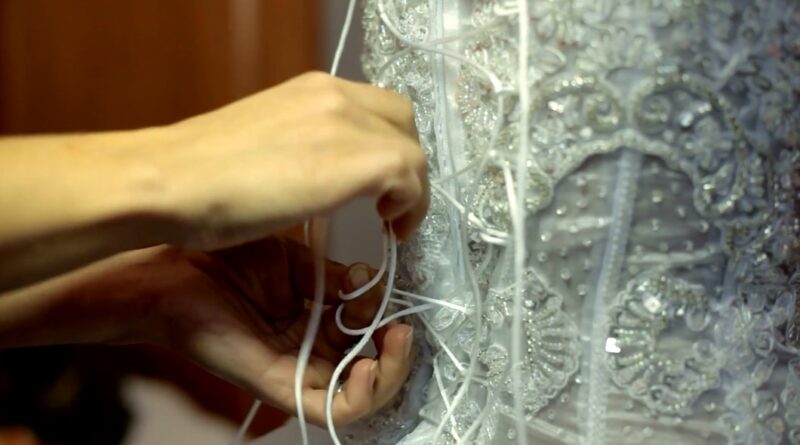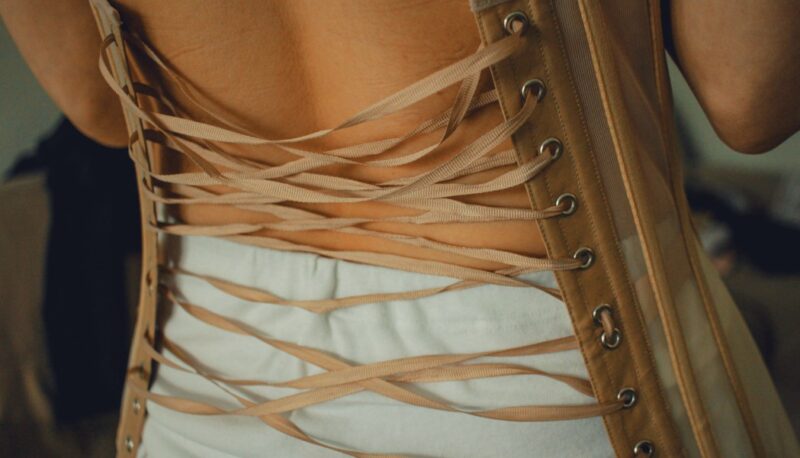A corset is a garment worn to hold and shape the torso into a desired shape for aesthetic or medical purposes. The history of corsets dates back to the 16th century and they have evolved significantly over time. Traditionally made from a flexible material such as cloth, particularly cotton, and stiffened with boning, corsets are typically fastened at the front or back by lacing.
Choosing the Right Corset

Before learning how to tie a corset, selecting the right one is crucial. Corsets come in various styles and sizes. Underbust corsets begin just under the breasts and extend down towards the hips.
Overbust corsets cover the breasts. Waist cinchers and waspies, shorter versions of the traditional corset, focus on reducing the waist size. Corsets are also differentiated based on their boning; steel boned corsets offer more support and rigidity compared to those with plastic boning.
Preparing to Lace Your Corset
Before tying a corset, wear a light garment like a camisole underneath to protect your skin and the corset lining. Ensure the corset is loose enough to wrap around your torso without strain. The laces should be fully extended.
The Process of Lacing a Corset
- Centering the Laces: Start by finding the middle of the corset’s laces. This center point should be positioned at the waist, which is the narrowest part of the torso.
- Working from Top and Bottom to Middle: Begin lacing the corset at the top, threading the laces through the eyelets in a crisscross fashion. Do the same from the bottom up to the waist. The laces should meet and cross in the middle.
- Tightening the Laces: Once the laces are threaded, gently pull each cross to tighten the corset. Start from the top and work your way down to the waist, then do the same from the bottom up. This method ensures an even tightening and a comfortable fit. It’s important to tighten gradually and not to pull too hard, as this could damage the corset or cause discomfort.
Securing the Corset

Once the corset feels snug and evenly tightened, tie the laces at the waist. This can be done in a simple bow or knot. Ensure the bow is tight enough to hold but not so tight that it’s difficult to untie. The excess lace can be tucked into the corset or left hanging, depending on preference and comfort.
Wearing the Corset Comfortably
Wearing a corset requires adjustment time. Initially, it should be worn for short periods to allow the body to adapt. Gradually increase the time as comfort grows. It’s important to listen to your body and not lace the corset too tightly, as this can lead to discomfort and health issues.
Safety and Maintenance Tips
- Breathing and Comfort: Ensure that you can breathe comfortably and move with reasonable ease.
- Cleaning and Storage: Corsets should be cleaned according to the manufacturer’s instructions. Store them in a way that maintains their shape and prevents damage.
- Health Considerations: Consult a doctor before wearing a corset, especially if you have underlying health conditions.
Adjusting to Corset Wear
As you begin to wear your corset more frequently, your body will start to adjust to its shape. It’s important to increase the duration gradually. Begin with a few hours a day and slowly extend the time. Pay attention to your body’s signals. If you experience discomfort or pain, loosen the corset or take a break from wearing it.
Lacing Techniques Variations
While the basic crisscross lacing is common, there are variations. The bunny ears technique, for instance, creates loops at the waistline for easier tightening. Another method is the inverted bunny ears, which is similar but the loops are formed under the waistline. These methods provide more control over the tightening process and are helpful for those who wear corsets regularly.
Corset and Fashion
Corsets have made a comeback in fashion. They can be worn as undergarments or as a part of an outer ensemble. When wearing a corset as an outer garment, consider the style and material.
Lace, satin, and velvet corsets are popular for their aesthetic appeal. Pairing a corset with high-waisted pants or a skirt can create a sophisticated look. For a bold statement, some choose to wear the corset over a dress or a blouse.
Health and Corsetry
It’s a myth that corsets are inherently harmful. When used responsibly, they can be a safe part of your wardrobe. However, over-tightening or wearing a poorly fitted corset can lead to issues. It’s crucial to choose a corset that fits well and to lace it to a comfortable tightness. Listening to your body and not exceeding its limits is key to healthy corset wear.
Customization and Personalization

Many corset wearers enjoy customizing their corsets. This can be as simple as changing the laces to a different color or as complex as adding embellishments like beads or embroidery. Customization allows wearers to express their personal style and make their corset unique.
FAQs
Can I sleep in my corset?
It’s generally not recommended to sleep in a corset, especially for beginners. Sleeping in a corset can restrict natural movement and breathing patterns during sleep. If someone chooses to do so for waist training purposes, it should be a well-fitted, comfortable corset, and they should gradually acclimate to wearing it for extended periods.
How do I know if my corset is too tight?
Signs that your corset is too tight include difficulty breathing, sharp pains, bruising, or feeling lightheaded. A well-laced corset should feel snug but not painful. It should compress evenly without pinching any specific area. If you experience any discomfort, loosen the laces immediately.
Can men wear corsets?
Absolutely. Corsets are not gender-specific. Men can wear corsets for fashion, posture improvement, or waist training. Corsets designed for men are shaped differently to accommodate a typically broader torso and less pronounced waist.
How long does it take to see waist training results with a corset?
Results vary depending on individual body types, how long and how often the corset is worn, and the tightness of lacing. Generally, with consistent wear, results can be seen in a few months. It’s important to remember that waist training is a gradual process and should not be rushed.
Is it safe to exercise in a corset?
Exercising in a traditional corset is not advisable. It can restrict movement and breathing, which is crucial during physical activity. However, there are fitness corsets or waist trainers designed specifically for exercise, offering more flexibility and breathability.
How do I care for my corset to ensure its longevity?
To maintain your corset, hand wash it in cold water with a mild detergent and air dry it away from direct sunlight. Avoid washing machines and dryers as they can damage the fabric and boning. Store it laid flat or hung by the laces to retain its shape. Regularly check for any wear and tear, especially around the boning and eyelets.
Final Thoughts
Wearing a corset can be a rewarding experience, both aesthetically and in terms of body confidence. By selecting the right corset, understanding how to properly lace it, and listening to your body, you can enjoy all that corsetry has to offer. Remember, comfort and safety are paramount. With these tips in mind, you can explore the world of corsets confidently and comfortably.
